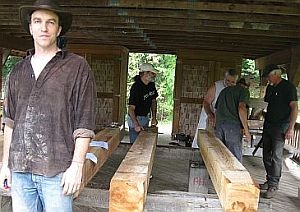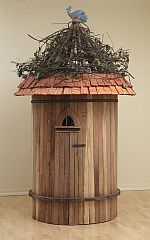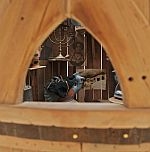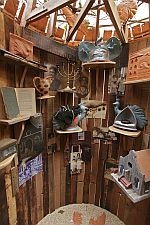
(Host) Today is Yom Kippur, the most solemn of Jewish holidays. It’s a time of fasting, repentance and prayer.
Traditionally at the end of fasting, Jewish families immediately started work on a hand-built structure used to celebrate the next holiday, Sukkot.
This weeklong harvest festival is often neglected in modern times. But in Bennington, where the local Jewish Community is celebrating its hundredth anniversary, the tradition is taking on new meaning.
VPR’s Susan Keese has more.
(Keese) At the edge of the woods near the Bennington museum, members of the Beth El Congregation are measuring and marking ten and 12 foot posts and beams.
They’re working with a timber-framer on a sukkah for Sukkot. It’ll be raised in a meadow near the museum.
Beth El Rabbi Joshua Boetigger says the sukkah symbolizes his people’s nomadic history.
(Boetigger) "Basically you build a temporary structure… And you live in it for a week. And you sleep in it, you live in it, you pray in it."
(Keese) This sukkah will have traditional corn stalk walls and woven branches on the roof. But Boetigger says it will be the first timber frame Sukkah he’s seen.
(Boetigger) "I think it’s a marriage of Vermont and Judaism that makes sense."
(Keese) In Bennington, that marriage dates back to 1909, when Rabbi Isaac Leader and his wife Freda left Eastern Europe and settled in this mostly Christian region.
(Boetigger) "And he used to travel around in a cart with books to teach Jewish kids sprinkled throughout the valley here in exchange for chickens."
(Keese) For Rabbi Isaac’s grandson, Emmett Leader, the story has long been one of dislocation and loss because of his own experience as a Jew in Vermont.
 Leader is an artist. And to tell his very personal version of his grandparents’ tale, he’s created a series of sukkahs and other artworks on exhibit at the Bennington Museum.
Leader is an artist. And to tell his very personal version of his grandparents’ tale, he’s created a series of sukkahs and other artworks on exhibit at the Bennington Museum.
The work is made of wood and painted, carved and sculpted clay, with photographs and text and natural objects. The colors are silver and turquoise and terra cotta.
(Leader) "All these things are various sorts of homes. I mean that’s what it’s really about. It’s about finding a home."
(Keese) Leader spent much of his childhood on a nonworking farm in Southern Vermont. He loved the land and the rural lifestyle.
 (Leader) "But it’s not Jewish. There’s no Jewish element. So well you could say, a Jew from Vermont, go to New York City. So you go to New York City and well, there’s Jews here but it’s a different texture than what you find in the country."
(Leader) "But it’s not Jewish. There’s no Jewish element. So well you could say, a Jew from Vermont, go to New York City. So you go to New York City and well, there’s Jews here but it’s a different texture than what you find in the country."
(Keese) Leader’s quest for a place where he belonged took him to Israel, then back to Vermont, and away again. It wasn’t until he discovered the wooden synagogues and earthy imagery of his grandparents’ home village in Ukraine that he found a world that was both Jewish and agrarian.
The Sukkahs in the show represent that rural town.
 (Leader) "This piece is called slonum revisited. And basically it was a way for me to go back to the world that they left."
(Leader) "This piece is called slonum revisited. And basically it was a way for me to go back to the world that they left."
(Keese) A carved clay triptych on a wall depicts his grandfather’s decline in Bennington from a Rabbi in a wagon filled with books to a dealer in chickens and eventually pigs…
But Leader says his personal story is still evolving. And helping to celebrate the Bennington Congregation’s hundredth birthday is part of that.
(Leader) "Because to be invited to a place in Vermont where my grandparents lived is an amazing experience because I get to be who I am, in a place where I thought I never could be as a Jew."
(Keese) Leader says the Beth El Congregation now appears to be thriving, and experimenting with projects like the timber frame Sukkah — that he would have loved in his own younger days.
And Leader says that’s something to celebrate.
For VPR News, I’m Susan Keese.